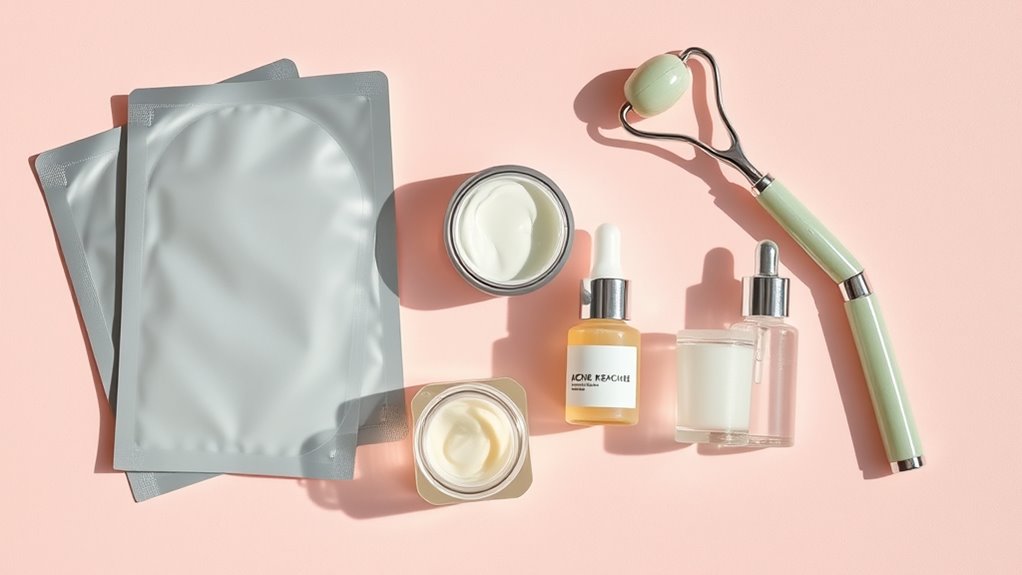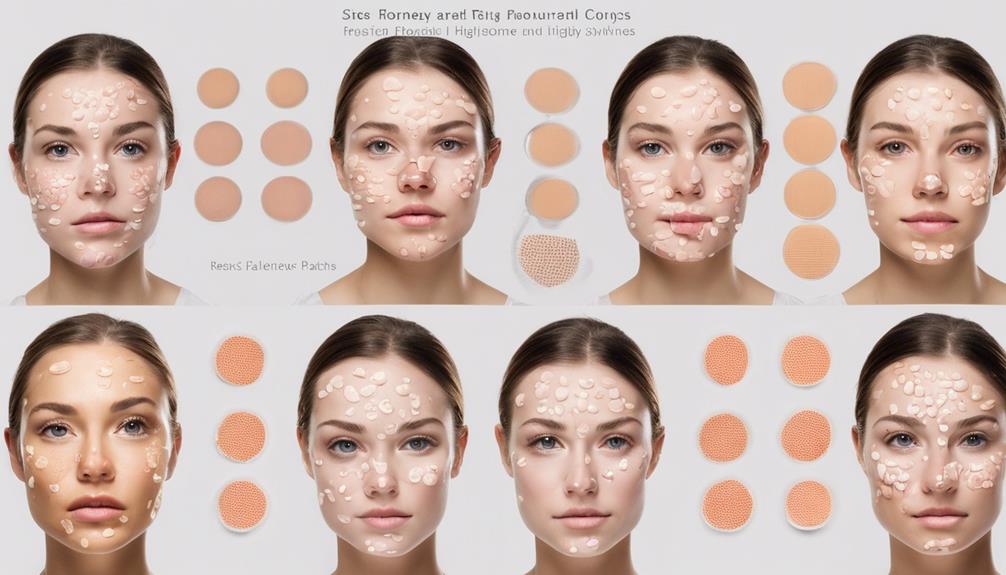To get the best results, apply acne patches after cleansing and toning to guarantee your skin is clean and dry. Avoid using exfoliating acids or strong serums beforehand, as they can affect adhesion. Place the patch directly on the blemish and leave it on for several hours or overnight. Incorporating patches at this stage helps prevent irritation and speeds healing. Keep exploring for more tips to optimize your skincare routine.
Key Takeaways
- Apply acne patches after cleansing and toning, ensuring skin is dry and free of active ingredients for optimal adhesion.
- Use patches after applying treatment serums but before moisturizing to target blemishes effectively.
- Leave patches on for several hours or overnight, integrating into your routine during the treatment or overnight step.
- Incorporate patches consistently during breakout-prone seasons to prevent new blemishes while maintaining overall routine balance.
- Follow with your moisturizer and sun protection after removing patches, completing your multi-step routine.

In the world of multi-step Korean skincare routines, acne patches have become a popular and effective tool for targeted blemish treatment. They serve as a quick fix, helping you reduce inflammation and absorb impurities directly from the spot. To maximize their benefits, it’s essential to understand where they fit into your routine. Applying acne patches at the right time can substantially enhance pimple prevention and leverage ingredient efficacy. When used correctly, they act as a barrier that not only protects your skin from further irritants but also creates an environment conducive to healing.
Proper timing maximizes acne patch benefits and promotes faster healing.
The key to pimple prevention lies in incorporating acne patches at the correct stage of your routine. Typically, you should apply the patch after cleansing and toning, once your skin is thoroughly prepared. This ensures the patch adheres properly and delivers maximum effect. If you use actives like exfoliating acids or strong serums beforehand, it could compromise the patch’s adhesion or cause unnecessary irritation. So, keep your routine simple up to that point. Once your skin is clean, dry, and free of residual products, place the patch directly on the blemish. Doing this at the right moment prevents the pimple from worsening and helps contain bacteria or dirt that could worsen inflammation.
Ingredient efficacy is another vital aspect. Many acne patches contain active ingredients such as hydrocolloid, salicylic acid, or tea tree oil. Hydrocolloid, the most common component, works by absorbing excess oil and pus, reducing swelling and promoting faster healing. Salicylic acid penetrates deeply to dissolve debris and unclog pores, preventing future breakouts. Tea tree oil offers natural antibacterial properties, reducing the risk of infection and further inflammation. When choosing patches, look for those with ingredients backed by scientific evidence. The right combination enhances pimple prevention, minimizes scarring, and speeds up recovery.
Timing and consistency matter. Applying an acne patch right after your cleansing routine ensures it works efficiently, especially if you’re targeting active blemishes. Leaving the patch on for the recommended period—usually several hours or overnight—maximizes absorption and healing. Regular use, especially during breakout-prone seasons, can help prevent new blemishes from forming. Additionally, understanding that high-quality projectors with color accuracy can significantly elevate your viewing experience emphasizes the importance of choosing the right tools for your routine. Remember, though, that patches aren’t a cure-all. They work best as part of a thorough routine that includes proper cleansing, hydration, and sun protection.
Frequently Asked Questions
Can Acne Patches Be Used With Other Spot Treatments Simultaneously?
You can use acne patches with other spot treatments, but be cautious with combination therapy and patch layering. Applying multiple products at once might cause irritation or diminish effectiveness. To avoid this, apply the acne patch first and wait a few minutes before adding other spot treatments. This helps ensure each product works properly without interfering with the patch’s ability to absorb impurities and deliver targeted care.
How Long Should I Leave Acne Patches on Before Removing?
You should leave the acne patch on for the recommended patch duration, usually about 6-8 hours or overnight. This allows the patch to effectively absorb impurities and reduce inflammation. Avoid premature patch removal, as it can lessen its benefits. When it’s time, gently remove the patch to prevent irritation. Always follow the product instructions for best results and to avoid skin irritation.
Are There Specific Ingredients to Avoid in Acne Patches?
You should avoid acne patches with ingredients to avoid that could irritate your skin or cause breakouts. Steer clear of harsh chemicals like alcohol, fragrances, and certain preservatives. Check the patch formulation for potential irritants or allergens. Opt for patches with soothing ingredients like tea tree oil or salicylic acid, but always patch-test new products to guarantee they won’t harm your skin or worsen your acne.
Can Acne Patches Cause Skin Irritation or Allergic Reactions?
You might think it’s smooth sailing, but acne patches can sometimes cause skin irritation or allergic reactions. If you have skin sensitivity or allergy risks, it’s wise to patch-test first. Ingredients like certain fragrances or adhesives could trigger a reaction. Always read labels carefully, and if you notice redness, swelling, or discomfort, stop use immediately. Being cautious helps you avoid unnecessary irritation and keeps your skin happy.
How Do I Store Acne Patches to Maintain Their Effectiveness?
To keep your acne patches effective, follow proper storage tips. Store them in a cool, dry place away from direct sunlight, which can degrade their adhesive and active ingredients. make certain the packaging is sealed tightly after each use to prevent contamination. Proper storage extends the patch lifespan and maintains their stickiness and effectiveness, so you get the best results when applying them to your skin.
Conclusion
Incorporating acne patches into your multi-step Korean routine can truly enhance your skin’s clarity. For example, imagine waking up with a stubborn pimple; applying a patch overnight could reduce inflammation and speed healing. Just like Sarah did, who saw her breakout diminish in just a few days after consistent use. So, give these patches a try—they’re a simple, effective way to tackle stubborn spots while maintaining your overall skincare routine.










